Northern Flames – Remembering Columba & Adomná¡n
Published in Features, Issue 3 (Autumn 1999), Medieval History (pre-1500), Volume 7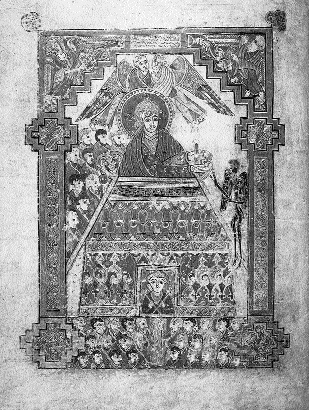
The second temptation of Christ from the Book of Kells-medieval tradition held Columba to have been the scribe. (Courtesy of the Board of Trinity College, Dublin)
Whether or not Glenveagh, County Donegal, and Scotland’s Great Glen are geologically connected is a question best left to specialists, but the fact remains that they look very much alike. Both are corridors through highland landscapes and both are routes of communication. Both were known to Columba. He was born c. 521 and his birth-place, according to respectable tradition, was close to Glenveagh at Gartan (a site spoiled, incidentally, in his 1,400th anniversary year for the sake of car-parking and a presidential visit). We have no proof that he or his people used the Glenveagh route to pass from the west coast of Donegal to Sheephaven Bay, thence, potentially, taking ship for Scotland, an area linguistically identical at the material time. But we have the assurance of Adomnán’s Vita Columbae that the saint later travelled the Great Glen to call on a Pictish king. His journey was accomplished partly by boat on Loch Lochy and Loch Ness; Glenveagh Lough, though smaller (inevitably) is similarly finger-like and might have been used (with Glen Lough, which lies on the same fault) to shorten the road. The landscape of Donegal and that of western Scotland look like a continuum to the modern traveller; we need not think that Columba felt differently.
The onomastic pattern is a man-made overlay on the land, a net of place-names which both interpret and describe, and there are parallels by the score between Ireland and Scotland. Consider Log na gCapall, Carraig na gCaorach, Céim na Caillí and sundry others, attesting complimentary naming processes on both sides of the water. Such names post-date Columba, but it would be hard to assign priority to either side. Like Adam naming the animals, the peoples who named the land completed, in a sense, the process of creation; theirs was certainly a creative act. There were like-minded people, then, in Ireland and (Picts excepted) in Scotland, speaking one language, and Columba moved easily among them all. Whether Scotland had been settled from Ireland (specifically from Dál Riata) is less certain, despite the strength of tradition, but the point was scarcely relevant to a sixth-century man.
From Atlantic Ireland to Atlantic Scotland
Columba migrated, for he never emigrated, from Atlantic Ireland to Atlantic Scotland, from one area of Irish speech to another. His adopted home on Iona offered a view of Mull’s Ben More, its profile surely reminding him of the familiar shape of Muckish; it offered a view of Jura, the only point (or points, since we speak of the Paps) visible equally with the naked eye from Iona and Ireland, at least in this writer’s experience. Mariners were accustomed to sight over long distances and to navigate by coastal features, and we can have no doubt that Columba and his brethren carried mental if not indeed physical maps.
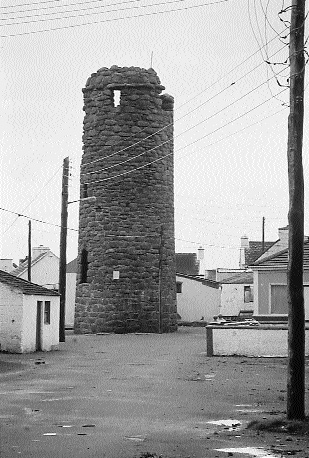
The round tower, Tory Island. (Cormac Bourke)
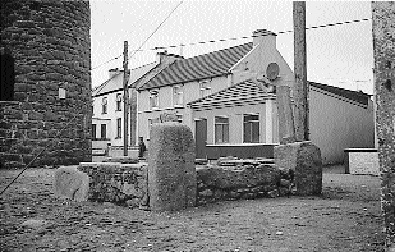
Ulaí Eoin Baiste or St John’s Alter, Tory Island-site of a free-standing cross? (Cormac Bourke)
Columba (‘dove’ in Latin) or Colum Cille (‘dove of the Church’ in Irish) belonged to the ruling kindred of the Cenél Conaill, one of the two principal divisions of the Northern Uí Néill. His career is described by Adomnán and some vital chronology is supplied independently by the Annals of Ulster and Bede. His foundation of Iona c. 563 is not in doubt, but what he did beforehand is less certain. Adomnán tells almost nothing (though he must have had information), and later tradition reflects, unsurprisingly, later ecclesiastical politics. But Columba was more than forty before he left Ireland. How did he spend his first forty years, the years of his youth and his coming to maturity? Study, undoubtedly, absorbed him, since a knowledge of Scripture and the Fathers was not to be acquired overnight. An act of foundation in Ireland is witnessed only in the case of Durrow, which was established—but from Iona—c. 585. But if this was Columba’s forte he might—before he was forty—have founded other churches on Irish soil in a quasi-experimental vein, trying to achieve a combination of circumstances (spiritual, spatial and political) which Iona was ultimately to afford. Tory is the obvious candidate, a place first mentioned in 617 in a record of a piratical raid. No church is mentioned, but what can have concerned the chronicler if not the Columban monastery ‘constructed’ (or, as it may be, re-constructed) in 621? The island is reminiscent (one might almost say ‘preminiscent’) of Iona in size and shape but less hospitable and, in Columban terms, perhaps too close to home. There are other reminiscences: a congeries of stones on Tory, surely once the site of a free-standing cross, is known as Ulaí Eoin Baiste or St John’s Altar and the name of St John is attached to an early Iona cross (even if tradition prefers the Baptist in one case, the Evangelist in the other). The same ‘altar’ on Tory incorporates a stone trough which is duplicated on Iona, and both were perhaps used for the semi-formal foot-washing to which Adomnán twice refers. Such sculpture must post-date Columba, but it hints at common régimes. The archaeology of Tory amounts to relatively little, but evidence might yet emerge for the existence of the monastery during the sixth-century lifetime of its patron and potential founder.
Not a missionary role
After 563, Adomnán’s benchmark, Columba was first and foremost a father to his monks. His was not a missionary role but the pursuit of the monastic vocation, and evangelism is rarely mentioned by Adomnán. The Vita Columbae instead asserts the sainthood of Columba through ‘prophetic revelations’, ‘miracles of power’ and ‘angelic visitations’. That sainthood is portrayed as something perceptible to the initiated, vouchsafed first to an inner circle, as something noised abroad only gradually like concentric ripples in water. Thus, Adomnán claims, the fame of the saint came to be known ‘not only in our own Ireland and in Britain, the largest of the ocean’s islands, but… also reached the three corners of Spain and Gaul and Italy beyond the Alps, and even Rome itself, the chief of all cities’.
Columba’s experience was that of the pioneer churchman, someone of independent mind with qualities of leadership who was capable of inspiring others and who retained that capacity in death (an ingredient essential to sainthood). He had dealings with kings of the Picts and the Britons, of Ireland and of Scottish Dál Riata. We learn of these contacts from Adomnán, who also reveals that Columba enjoyed the friendship of Brendan of Clonfert, Comgall of Bangor and Cainnech of Aghaboe. This is no fiction, but reliable evidence that these four, with others, were a marked generation, a peer-group who directed the social revolution which was the florescence of monasticism in Ireland and Britain. These men, and the few women we hear of, must have been of like mind.
Columba died in 597 and was revered as a saint in common with his deceased contemporaries. He was culted after his death through material things and, at a date unknown but certainly before 818, his bones were translated from the grave into one or more above-ground shrines. He inspired a love of learning, if the achievements of his successor abbots are any guide, and Adomnán was pre-eminent among them. These men were typically priests and not bishops, but two may have been exceptions to the rule: Fergna ‘the Briton’, the fourth abbot, is called a bishop in late sources (perhaps having worked in Strathclyde); Cillíne, the fourteenth, was dubbed Droichtech in Irish, a term we might translate ‘bridge-builder’ and by extension pontifex or ‘bishop’. The abbots were for the most part of Columba’s own kin (the two just named excepted), and were, it seems certain, celibate.
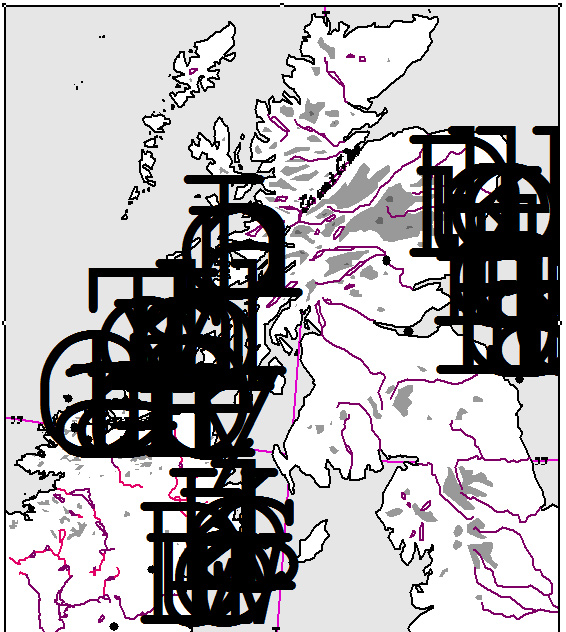
(Matthew Stout)
The familia headed by Iona straddled Ireland, Scotland and Northumbria (for it included Lindisfarne), but only briefly, given Northumbrian realignment after 664. The Irish-Scottish axis flourished, although the foundation of Kells in 807 marked the beginning of a long process whereby the special position of Iona was eclipsed. This eclipse, or supersession, is often thought to have been planned, but Kells might have been at first an organic offshoot as Durrow had been before. Even after the primacy had migrated to Kells in the tenth century, to Derry in the twelfth, religious life on Iona was maintained. The shift in the ecclesiastical centre of gravity was linked to the Viking threat, to the new alliance of the Columban hierarchy with the Southern Uí Neill and, last but not least, to the move by the kings of the united Picts and Scots to central Scotland in the vicinity of modern Perth. There Dunkeld housed relics of Columba; still later Inchcolm in the Firth of Forth was a focus of his cult. The fourteenth-century Inchcolm Antiphoner contains a unique collection of words and music composed in Columba’s praise.
Book of Kells
It is for its artistic output that the Columban Church is best remembered. The Book of Kells is the chief monument in a gallery which embraces manuscripts, literature, sculpture, metalwork and music. There is no evidence that Giraldus Cambrensis had the Kells codex in mind when he spoke of a manuscript at Kildare (for he knew his way around); neither is there any evidence that the book is a product of two places—begun on Iona c. 800 and finished at Kells (indeed it was never, strictly speaking, finished). That is an art-historian’s special pleading.
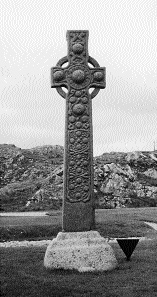
St Martin’s Cross, Iona. (Cormac Bourke)
There is evidence, however, for the presence of the manuscript at Kells by the middle of the ninth century, which is when its Temptation scene inspired a local sculptor. Whether produced in Ireland or Scotland (and we will probably never know), medieval tradition held Columba to have been the scribe.
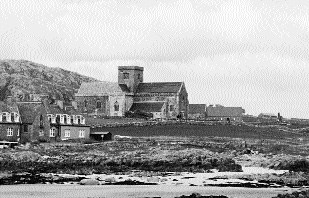
The abbey on Iona, probable site of Columba’s first church. (Cormac Bourke)
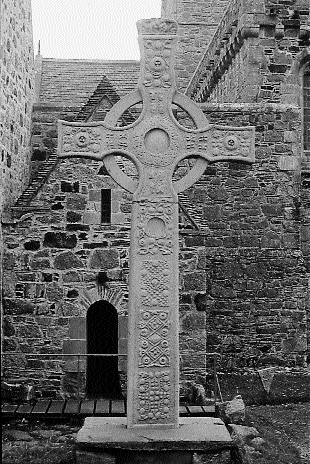
Replica (1970) of St John’s Cross, Iona. (Richard Warner)
Later tradition speaks, likewise, of Columba having returned but once to Ireland from his ‘exile’ with Scottish sods tied under his feet, thus keeping his vow never again to walk on Irish soil. The Glasgow Celtic pitch at Parkhead was inaugurated in 1892 with a sod from Donegal laid by Michael Davitt (and stolen, as it happens, soon after). Sods have long been held to have an essential or elemental quality and this two-way traffic is not without irony: there is no evidence that Columba and his Iona successors would have had any truck with symbolic sods, for theirs was a geography of continuities and Iona itself was hallowed ground.
Cormac Bourke is Curator of Medieval Antiquities at the Ulster Museum, Belfast
Further reading:
C. Bourke (ed.), Studies in the Cult of Saint Columba (Dublin 1997).
D. Broun and T. Clancy (eds.) Spes Scotorum, Hope of Scots: St Columba, Iona and Scotland (Edinburgh 1999).
M. Herbert, Iona, Kells, and Derry, the History and Hagiography of the Monastic Familia of Columba (Oxford 1988).
R. Sharpe (trans.) Adomán of Iona, Life of Columba (Harmondsworth 1995).
















